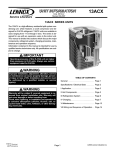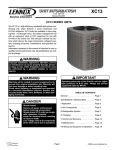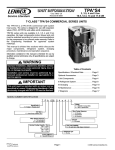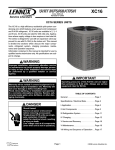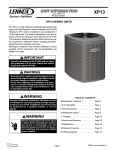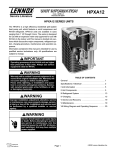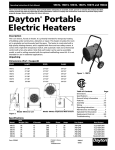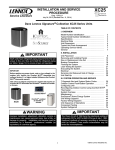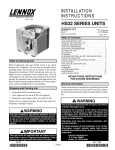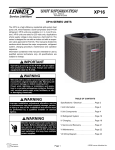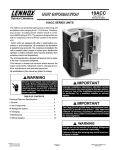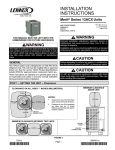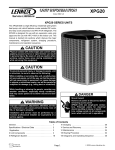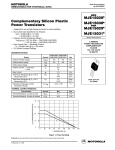Download 13ACX Product Detail Sheet
Transcript
Service Literature Corp. 0612−L2 Revised 07−2006 13ACX 13ACX SERIES UNITS The 13ACX is a high efficiency residential split−system condensing unit, which features a scroll compressor and designed for R−410A refrigerant. 13ACX units are available in sizes ranging from 1−1/2 through 5 tons. The series is designed for use with an expansion valve in the indoor unit. This manual is divided into sections which discuss the major components, refrigerant system, charging procedure, maintenance and operation sequence. Information contained in this manual is intended for use by qualified service technicians only. All specifications are subject to change. IMPORTANT Operating pressures of this R−410A unit are higher than pressures in R−22 units. Always use service equipment rated for R−410A. WARNING Improper installation, adjustment, alteration, service or maintenance can cause property damage, personal injury or loss of life. Installation and service must be performed by a qualified installer or service agency. TABLE OF CONTENTS General . . . . . . . . . . . . . . . . . . . . . . . . . . . . Page 1 Specifications / Electrical Data . . . . . . . . . Page 2 I Application . . . . . . . . . . . . . . . . . . . . . . . . . Page 3 WARNING Warranty will be voided if covered equipment is removed from original installation site. Warranty will not cover damage or defect resulting from: Flood, wind, lightning, or installation and operation in a corrosive atmosphere (chlorine, fluorine, salt, recycled waste water, urine, fertilizers, or other damaging chemicals). Page 1 II Unit Components . . . . . . . . . . . . . . . . . . Page 3 III Refrigeration System . . . . . . . . . . . . . . . Page 6 IV Charging . . . . . . . . . . . . . . . . . . . . . . . . . Page 7 VI Maintenance . . . . . . . . . . . . . . . . . . . . . . Page 11 VII Wiring and Sequence of Operation . . Page 12 ©2006 Lennox Industries Inc. SPECIFICATIONS General D t Data Model No. 13ACX−018 13ACX−024 Nominal Tonnage (kW) 1.5 (5.3) 2 (7.0) Connections Liquid line o.d. − in. (mm) 3/8 (9.5) 3/8 (9.5) (sweat) Suction line o.d. − in. (mm) 3/4 (19.1) 3/4 (19.1) 1 Refrigerant (R-410A) furnished 4 lbs. 7 oz. 4 lbs. 14 oz. (2.01 kg) (2.21 kg) Outdoor Net face area Outer coil 13.22 (1.23) 15.11 (1.40) Coil - sq. sq ft. ft (m2) Inner coil −−− −−− Tube diameter − in. (mm) 5/16 (8) 5/16 (8) Number of rows 1 1 Fins per inch (m) 22 (866) 22 (866) Outdoor Diameter − in. (mm) 18 (457) 18 (457) Fan Number of blades 3 3 Motor hp (W) 1/5 (149) 1/5 (149) Cfm (L/s) 2500 (1180) 2500 (1180) Rpm 1100 1100 Watts 200 200 Shipping Data − lbs. (kg) 1 package 122 (55) 129 (59) 13ACX−030 2.5 (8.8) 3/8 (9.5) 3/4 (19.1) 6 lbs. 3 oz. (2.81 kg) 13.22 (1.23) 12.60 (1.17) 5/16 (8) 2 22 (866) 18 (457) 4 1/5 (149) 2450 (1155) 1100 200 150 (68) 13ACX−036 3 (10.6) 3/8 (9.5) 7/8 (22.2) 6 lbs. 7 oz. (2.92 kg) 13.22 (1.23) 12.60 (1.17) 5/16 (8) 2 22 (866) 18 (457) 4 1/5 (149) 2450 (1155) 1100 200 150 (68) 13ACX−042 3.5 (12.3) 3/8 (9.5) 7/8 (22.2) 8 lbs. 14 oz. (4.03 kg) 15.11 (1.40) 14.40 (1.34) 5/16 (8) 2 22 (866) 18 (457) 4 1/3 (249) 2930 (1385) 1100 310 177 (80) 13ACX−048 4 (14.1) 3/8 (9.5) 7/8 (22.2) 8 lbs. 4 oz. (3.74 kg) 16.33 (1.52) 15.71 (1.46) 5/16 (8) 2 22 (866) 22 (559) 4 1/4 (186) 3830 (1805) 825 330 233 (106) 13ACX−060 5 (17.6) 3/8 (9.5) 1-1/8 (28.6) 11 lbs. 2 oz. (5.05 kg) 24.50 (2.28) 23.56 (2.19) 5/16 (8) 2 22 (866) 22 (559) 4 1/4 (186) 3830 (1805) 825 330 236 (107) 208/230V 30 18.7 14.1 .98 73 1.0 1.9 208/230V 35 21.9 16.6 .98 79 1.0 1.9 208/230V 40 24.1 17.9 .94 112 1.9 4.1 208/230V 50 28.9 21.8 .95 117 1.7 3.1 208/230V 60 34.5 26.2 .98 134 1.7 3.1 Factory ELECTRICAL DATA Line voltage data − 60 hz − 1ph overcurrent protection (amps) 3 Minimum circuit ampacity Compressor p Rated load amps Power factor Locked rotor amps Condenser Full load amps Fan Motor Locked rotor amps 2 Maximum 208/230V 20 12.3 9.0 .96 48 1.0 1.9 208/230V 30 17.9 13.4 .97 58 1.0 1.9 OPTIONAL ACcESSORIES − must be ordered extra 93M05 31J20 10J42 Compressor p Hard Start Kit 88M91 Compressor Low Ambient Cut−Off 45F08 Compressor Sound Cover 69J03 Compressor Time−Off Control 47J27 3/8 in. tubing 93G35 Freezestat 1/2 in. tubing 39H29 5/8 in. tubing 50A93 92M88 Hail Guards 92M89 45M56 92M94 Loss of Charge Kit 84M23 Low Ambient Kit 34M72 69J06 Mounting g Base 69J07 L15−41−20, L15−41−30, Refrigerant L15−41−40, L15−41−50 e Sets Line L15−65−30, L15−65−40, L15−65−50 Field Fabricate Time Delay Relay Kit 58M81 Unit Stand−Off Kit 94J45 Compressor p Crankcase H t Heater NOTE Extremes of operating range are plus 10% and minus 5% of line voltage. 1 Refrigerant charge sufficient for 15 ft. (4.6 m) length of refrigerant lines. 2 HACR type circuit breaker or fuse. 3 Refer to National or Canadian Electrical Code manual to determine wire, fuse and disconnect size requirements. Page 2 I − APPLICATION CONTROL BOX 13ACX condensing units are available in 1−1/2, 2, 2 -1/2, 3, 3 -1/2, 4 and 5 ton capacities. All major components (indoor blower and coil) must be matched according to Lennox recommendations for the compressor to be covered under warranty. Refer to the Engineering Handbook for approved system matchups. II − UNIT COMPONENTS DUAL CAPACITOR (C12) COMPRESSOR CONTACTOR (K1) Unit components are illustrated in figure 1. OUTDOOR FAN TIMED OFF CONTROL. (OPTION) GROUNDING LUG 13ACX PARTS ARRANGEMENT CAPACITOR TIMED OFF CONTROL (OPTION) FIGURE 2 1 − Compressor Contactor K1 DANGER CONTACTOR COMPRESSOR FIGURE 1 Shock Hazard Remove all power at disconnect before removing access panel. Single phase 13ACX units use single-pole contactors. Potential exists for electrical shock resulting in injury or death. Line voltage exists at all components (even when unit is not in operation). A − Control Box (Figure 2) 13ACX units are not equipped with a 24V transformer. All 24 VAC controls are powered by the indoor unit. Refer to wiring diagram. Electrical openings are provided under the control box cover. Field thermostat wiring is made to color-coded pigtail connections. ELECTROSTATIC DISCHARGE (ESD) Precautions and Procedures CAUTION Electrostatic discharge can affect electronic components. Take precautions during unit installation and service to protect the unit’s electronic controls. Precautions will help to avoid control exposure to electrostatic discharge by putting the unit, the control and the technician at the same electrostatic potential. Neutralize electrostatic charge by touching hand and all tools on an unpainted unit surface before performing any service procedure. Page 3 The compressor is energized by a single−pole contactor located in the control box. See figure 2. K1 is energized by the indoor thermostat terminal Y1 (24V) when thermostat demand is present. 2 − Dual Capacitor C12 The compressor and fan in 13ACX series units use permanent split capacitor motors. The capacitor is located inside the unit control box (see figure 2). A single dual" capacitor (C12) is used for both the fan motor and the compressor (see unit wiring diagram). The fan side and the compressor side of the capacitor have different MFD ratings. See side of capacitor for ratings. 3 − Timed Off Control TOC (option) The time delay is electrically connected between thermostat terminal Y and the compressor contactor. Between cycles, the compressor contactor is delayed for 5 minutes ± 2 minutes but may last as long as 8 minutes. At the end of the delay, the compressor is allowed to energize. When thermostat demand is satisfied, the time delay opens the circuit to the compressor contactor coil and the compressor is de−energized. B − Compressor The scroll compressor design is simple, efficient and requires few moving parts. A cutaway diagram of the scroll compressor is shown in figure 3. The scrolls are located in the top of the compressor can and the motor is located just below. The oil level is immediately below the motor. SCROLL COMPRESSOR Due to its efficiency, the scroll compressor is capable of drawing a much deeper vacuum than reciprocating compressors. Deep vacuum operation can cause internal fusite arcing resulting in damaged internal parts and will result in compressor failure. Never use a scroll compressor for evacuating or pumping−down" the system. This type of damage can be detected and will result in denial of warranty claims. The scroll compressor is quieter than a reciprocating compressor, however, the two compressors have much different sound characteristics. The sounds made by a scroll compressor do not affect system reliability, performance, or indicate damage. DISCHARGE NOTE − During operation, the head of a scroll compressor may be hot since it is in constant contact with discharge gas. SUCTION SCROLL FORM FIGURE 3 The scroll is a simple compression concept centered around the unique spiral shape of the scroll and its inherent properties. Figure 4 shows the basic scroll form. Two identical scrolls are mated together forming concentric spiral shapes (figure 5). One scroll remains stationary, while the other is allowed to "orbit" (figure 6). Note that the orbiting scroll does not rotate or turn but merely orbits the stationary scroll. The counterclockwise orbiting scroll draws gas into the outer crescent shaped gas pocket created by the two scrolls (figure 6 − 1). The centrifugal action of the orbiting scroll seals off the flanks of the scrolls (figure 6 − 2). As the orbiting motion continues, the gas is forced toward the center of the scroll and the gas pocket becomes compressed (figure 6 − 3). When the compressed gas reaches the center, it is discharged vertically into a chamber and discharge port in the top of the compressor (figure 5). The discharge pressure forcing down on the top scroll helps seal off the upper and lower edges (tips) of the scrolls (figure 5). During a single orbit, several pockets of gas are compressed simultaneously providing smooth continuous compression. The scroll compressor is tolerant to the effects of liquid return. If liquid enters the scrolls, the orbiting scroll is allowed to separate from the stationary scroll. The liquid is worked toward the center of the scroll and is discharged. If the compressor is replaced, conventional Lennox cleanup practices must be used. FIGURE 4 CROSS−SECTION OF SCROLLS DISCHARGE STATIONARY SCROLL DISCHARGE PRESSURE SUCTION TIPS SEALED BY DISCHARGE PRESSURE ORBITING SCROLL FIGURE 5 Page 4 SUCTION SUCTION 1 INTERMEDIATE PRESSURE GAS 2 ORBITING SCROLL CRESCENT SHAPED GAS POCKET STATIONARY SCROLL SUCTION POCKET FLANKS SEALED BY CENTRIFUGAL FORCE SUCTION SUCTION MOVEMENT OF ORBIT 3 4 HIGH PRESSURE GAS DISCHARGE POCKET FIGURE 6 C − Condenser Fan Motor All units use single−phase PSC fan motors which require a run capacitor. In all units, the condenser fan is controlled by the compressor contactor. ELECTRICAL DATA tables in this manual show specifications for condenser fans used in 13ACX ’s. Access to the condenser fan motor on all units is gained by removing the four screws securing the fan assembly. See figure 7. The grill fan assembly can be removed from the cabinet as one piece. See figure 8. The condenser fan motor is removed from the fan guard by removing the four nuts found on top of the grill. See figure 8 if condenser fan motor replacement is necessary. DANGER Make sure all power is disconnected before beginning electrical service procedures. ALIGN FAN HUB FLUSH WITH END OF SHAFT FIGURE 8 D − Loss of Charge Switch (option) An auto-reset, single-pole/single-throw low loss of charge switch is located in the suction line. This switch shuts off the compressor when suction pressure drops below the factory setting. The switch is closed during normal operating pressure conditions and is permanently adjusted to trip (open) at 25 + 5 psi. The switch automatically resets when suction line pressure rises above 55 + 5 psi. rises to 55 + 5 psig. E − High Pressure Switch Remove screws 13ACX units are equipped with a high pressure switch that is located in the liquid line. The switch (SPST, manual reset, normally closed) removes power from the compressor contactor control circuit when discharge pressure rises above factory setting at 590 + 10 psi. Remove screws FIGURE 7 Page 5 III − REFRIGERANT SYSTEM Service Valve (Valve Closed) A − Plumbing stem cap Field refrigerant piping consists of liquid and suction lines from the condensing unit (sweat connections) to the indoor evaporator coil (sweat connections). Use Lennox L15 (sweat) series line sets as shown in table 1. TABLE 1 Unit Liquid Line Suction Line L15 Line Sets −018 −024 −030 3/8 in. (10 mm) 3/4 in. (19 mm) L15−41 15 ft. − 50 ft. (4.6 m − 15 m) −036 −042 −048 3/8 in. (10 mm) 7/8 in. (22 mm) L15−65 15 ft. − 50 ft. (4.6 m − 15 m) −060 3/8 in. (10 mm) 1−1/8 in. (29 mm) Field Fabricated service port insert hex wrench here to outdoor coil service port cap to indoor coil Schrader valve open to line set when valve is closed (front seated) (valve front seated) Service Valve (Valve Open) The liquid line and vapor line service valves (figures 9 and 10) and gauge ports are accessible from the outside of the unit. Use the service ports for leak testing, evacuating, charging and checking charge. Each valve is equipped with a service port which has a factory−installed Schrader valve. A service port cap protects the Schrader valve from contamination and serves as the primary leak seal. Service valves are not rebuildable. If a valve has failed, you must replace it. To Access Schrader Port: 1 − Remove service port cap with an adjustable wrench. 2 − Connect gauge to the service port. 3 − When testing is complete, replace service port cap. Tighten finger tight, then an additional 1/6 turn. To Open Service Valve: 1 − Remove the stem cap with an adjustable wrench. 2 − Using the adjustable wrench to keep the valve stationary, use a service wrench with a hex−head extension to back the stem out counterclockwise as far as it will go. NOTE − Use a 3/16" hex head extension for 3/8" line sizes or a 5/16" extension for large line sizes. 3 − Replace the stem cap. Tighten finger tight, then tighten an additional 1/6 turn. To Close Service Valve: 1 − Remove the stem cap with an adjustable wrench. 2 − Using the adjustable wrench to keep the valve stationary, use a service wrench with a hex−head extension to turn the stem clockwise to seat the valve. Tighten the stem firmly. NOTE − Use a 3/16" hex head extension for 3/8" line sizes or a 5/16" extension for large line sizes. 3 − Replace the stem cap. Tighten finger tight, then tighten an additional 1/6 turn. NOTE − Stem cap must be replaced to help prevent valve leakage. Page 6 IV − CHARGING WARNING R−410A refrigerant can be harmful if it is inhaled. R−410A refrigerant must be used and recovered responsibly. Failure to follow this warning may result in personal injury or death. A − Leak Testing After the line set has been connected to the indoor and outdoor units, check the line set connections and indoor unit for leaks. IMPORTANT The Clean Air Act of 1990 bans the intentional venting of (CFC’s and HFC’s) as of July 1, 1992. Approved methods of recovery, recycling or reclaiming must be followed. Fines and/or incarceration my be levied for noncompliance. WARNING Fire, Explosion and Personal Safety Hazard. Failure to follow this warning could result in damage, personal injury or death. Never use oxygen to pressurize or purge refrigeration lines. Oxygen when exposed to a spark or open flame can cause damage by fire and or an explosion, that could result in personal injury or death. WARNING Danger of explosion: Can cause equipment damage, injury or death. When using a high pressure gas such as dry nitrogen to pressurize a refrigeration or air conditioning system, use a regulator that can adjust the pressure from 0 to 450 psig ( 3103 kPa). Using an Electronic Leak Detector 1 − Connect a cylinder of R−410A to the center port of the manifold gauge set. Connect manifold gauge to service valve port. 2 − With both manifold valves closed, open the valve on the R−410A cylinder. 3 − Open the high pressure side of the manifold to allow the R−410A into the line set and indoor unit. Weigh in a trace amount of R−410A. [A trace amount is a maximum of 2 ounces (57 g) or 3 pounds (31 kPa) pressure.] Close the valve on the R−410A cylinder and the valve on the high pressure side of the manifold gauge set. Disconnect the R−410A cylinder. 4 − Connect a cylinder of nitrogen with a pressure regulating valve to the center port of the manifold gauge set. Page 7 5 − Connect the manifold gauge set high pressure hose to the vapor valve service port. (Normally, the high pressure hose is connected to the liquid line port; however, connecting it to the vapor port better protects the manifold gauge set from high pressure damage.) 6 − Adjust the nitrogen pressure to 150 psig (1034 kPa). Open the valve on the high side of the manifold gauge set which will pressurize line set and indoor unit. 7 − After a few minutes, open a refrigerant port to ensure the refrigerant you added is adequate to be detected. (Amounts of refrigerant will vary with line lengths.) Check all joints for leaks. Purge nitrogen and R−410A mixture. Correct any leaks and recheck. B − Evacuating Evacuating the system of noncondensables is critical for proper operation of the unit. Noncondensables are defined as any gas that will not condense under temperatures and pressures present during operation of an air conditioning system. Noncondensables and water vapor combine with refrigerant to produce substances that corrode copper piping and compressor parts. NOTE − This evacuation process is adequate for a new installation with clean and dry lines. If excessive moisture is present, the evacuation process may be required more than once. IMPORTANT Use a thermocouple or thermistor electronic vacuum gauge that is calibrated in microns. Use an instrument that reads from 50 microns to at least 20,000 microns. 1 − Connect manifold gauge set to the service valve ports : low pressure gauge to vapor line service valve high pressure gauge to liquid line service valve 2 − Connect micron gauge. 3 − Connect the vacuum pump (with vacuum gauge) to the center port of the manifold gauge set. 4 − Open both manifold valves and start the vacuum pump. 5 − Evacuate the line set and indoor unit to an absolute pressure of 23,000 microns (29.01 inches of mercury). During the early stages of evacuation, it is desirable to close the manifold gauge valve at least once to determine if there is a rapid rise in absolute pressure. A rapid rise in pressure indicates a relatively large leak. If this occurs, repeat the leak testing procedure. NOTE − The term absolute pressure means the total actual pressure within a given volume or system, above the absolute zero of pressure. Absolute pressure in a vacuum is equal to atmospheric pressure minus vacuum pressure. 6 − When the absolute pressure reaches 23,000 microns (29.01 inches of mercury), close the manifold gauge valves, turn off the vacuum pump and disconnect the manifold gauge center port hose from vacuum pump. Attach the manifold center port hose to a nitrogen cylinder with pressure regulator set to 150 psig (1034 kPa) and purge the air from the hose with nitrogen. Open the manifold gauge valves to break the vacuum in the line set and indoor unit. Close the manifold gauge valves. CAUTION Danger of Equipment Damage. Avoid deep vacuum operation. Do not use compressors to evacuate a system. Extremely low vacuums can cause internal arcing and compressor failure. Damage caused by deep vacuum operation will void warranty. 7 − Shut off the nitrogen cylinder and remove the manifold gauge hose from the cylinder. Open the manifold gauge valves to release the nitrogen from the line set and indoor unit. 8 − Reconnect the manifold gauge to the vacuum pump, turn the pump on, and continue to evacuate the line set and indoor unit until the absolute pressure does not rise above 500 microns (29.9 inches of mercury) within a 20−minute period after shutting off the vacuum pump and closing the manifold gauge valves. 9 − When the absolute pressure requirement above has been met, disconnect the manifold hose from the vacuum pump and connect it to an upright cylinder of R−410A refrigerant. Open the manifold gauge valves to break the vacuum from 1 to 2 psig positive pressure in the line set and indoor unit. Close manifold gauge valves and shut off the R−410A cylinder and remove the manifold gauge set. C − Charging This system uses R−410A refrigerant which operates at much higher pressures than R−22. The provided liquid line filter drier is approved for use with R−410A. Do not replace it with components designed for use with R−22. This unit is NOT approved for use with coils which use capillary tubes as a refrigerant metering device. Factory Charge Units are factory-charged with the amount of R−410A refrigerant indicated on the unit rating plate. This charge is based on a matching indoor coil and outdoor coil with 15 ft. (4.6 m) line set. For varying lengths of line set, refer to table 2 for refrigerant charge adjustment. TABLE 2 IMPORTANT Mineral oils are not compatible with R−410A. If oil must be added, it must be a polyol ester oil. NOTE − The compressor is charged with sufficient polyol ester oil for line set lengths up to 50 feet (15.2 m). If oil must be added to the compressor in the field, Copeland has approved Mobil EALt Arctic 22CC and ICI EMKARATEt RL32CF. Checking Charge The outdoor unit should be charged during warm weather. However, applications arise in which charging must occur in the colder months. The method of charging is determined by the unit’s refrigerant metering device and the outdoor ambient temperature. Measure the liquid line temperature and the outdoor ambient temperature as outlined below: 1.Connect the manifold gauge set to the service valves: low pressure gauge to vapor valve service port high pressure gauge to liquid valve service port Close manifold gauge set valves. Connect the center manifold hose to an upright cylinder of R−410A . 2.Set the room thermostat to call for heat. This will create the necessary load for properly charging the system in the cooling cycle. 3.Use a digital thermometer to record the outdoor ambient temperature. 4.When the heating demand has been satisfied, switch the thermostat to cooling mode with a set point of 68F (20C). When pressures have stabilized, use a digital thermometer to record the liquid line temperature. 5.The outdoor temperature will determine which charging method to use. Proceed with the appropriate charging procedure. Charge Using Weigh−in Method − Outdoor Temp. <65°F (18°C) If the system is void of refrigerant, or if the outdoor ambient temperature is cool, use the weigh−in method to charge the unit. Do this after any leaks have been repaired. 1.Recover the refrigerant from the unit. 2.Conduct a leak check, then evacuate as previously outlined. 3.Weigh in the charge according to the total amount shown on the unit nameplate. If weighing facilities are not available or if you are charging the unit during warm weather, use the approach method that follows. Refrigerant Charge per Line Set Lengths Liquid Line Set Diameter Oz. per 5 ft. (g per 1.5 m) adjust from 15 ft. (4.6 m) line set* 3/8 in. (9.5 mm) 3 ounce per 5 ft. (85 g per 1.5 m) NOTE − *If line length is greater than 15 ft. (4.6 m), add this amount. If line length is less than 15 ft. (4.6 m), subtract this amount. Page 8 TABLE 3 Charge Using Approach Method − Outdoor Temperature >65°F (18°C) 13ACX Approach Values When charging an expansion valve system when the outdoor ambient temperature is 65F (18C) or above, it is best to charge the unit using the approach method. Subtract the outdoor ambient temperature from the liquid line temperature to determine the approach temperature (see table 3). The resulting difference (approach temperature) should agree with the values given in table 3. If not, add refrigerant to lower the approach temperature or recover refrigerant from the system to increase the approach temperature. °F (°C)* Model Use table 4 to perform maintenance checks. Table 4 is not a procedure for charging the system. Minor variations in these pressures may be due to differences in installations. Significant deviations could mean that the system is not properly charged or that a problem exists with some component in the system. º º º −018 −024 Liquid Line Temperature ºF (ºC) Outdoor Temperature ºF (ºC) Approach Temperature ºF (ºC) −030 −036 −042 −048 −060 10.1 65 (18) 8.2 10.9 8.6 16.1 9.3 6.2 70 (21) 8.5 11.0 8.6 15.6 10.3 5.2 9.8 75 (24) 8.3 10.8 8.6 15.8 10.8 6.1 10.0 80 (27) 8.3 10.8 8.7 15.7 11.0 6.2 9.9 85 (29) 8.1 10.6 8.8 15.8 10.6 6.2 9.2 90 (32) 8.4 10.5 8.8 15.5 10.2 6.0 9.3 95 (35) 8.2 10.0 8.6 15.3 10.0 5.8 9.0 100 (38) 7.8 9.2 8.6 15.0 9.8 5.8 8.8 105 (41) 7.6 9.1 8.4 14.8 9.7 5.4 8.6 110 (43) 7.2 8.7 8.3 14.5 9.0 4.9 8.6 115 (45) 7.3 8.2 8.6 14.4 8.4 4.7 8.8 Checking Charge Using Normal Operating Pressures IMPORTANT = NOTE − For best results, use the same electronic thermometer to check both outdoor-ambient and liquid-line temperatures. *F: +/−1.0°; C: +/−0.5° TABLE 4 13ACX Normal Operating Pressures Model −018 −024 −030 −036 −042 −048 −060 Values below are typical pressures; indoor unit match up, indoor air quality equipment, and indoor load will cause the pressures to vary. *Temp. 5F (5C) Liquid Line Pressure / Vapor Line Pressure Liquid / Vapor Liquid / Vapor Liquid / Vapor Liquid / Vapor Liquid / Vapor Liquid / Vapor Liquid / Vapor 65 (18) 244 / 135 249 / 137 241 / 134 253 / 134 250 / 135 240 / 130 247 / 129 70 (21) 262 / 136 268 / 138 259 / 135 274 / 135 268 / 137 257 / 131 265 / 130 75 (24) 281 / 137 288 / 138 279 / 136 293 / 136 288 / 138 278 / 132 286 / 131 80 (27) 302 / 138 309 / 140 300 / 137 315 / 137 310 / 139 299 / 133 310 / 132 85 (29) 323 / 139 331 / 140 322 / 138 338 / 139 332 / 140 323 / 134 330 / 132 90 (32) 346 / 141 355 / 142 345 / 140 361 / 139 356 / 140 344 / 135 353 / 133 95 (35) 369 / 142 379 / 143 369 / 141 385 / 141 381 / 141 369 / 136 375 / 134 100 (38) 394 / 143 402 / 144 393 / 142 410 / 142 406 / 143 394 / 137 400 / 136 105 (41) 417 / 145 430 / 145 418 / 143 436 / 143 432 / 143 418 / 139 426 / 137 110 (43) 445 / 146 457 / 146 445 / 144 463 / 145 459 / 145 446 / 140 451 / 139 115 (45) 476 / 148 485 / 147 474 / 145 491 / 146 490 / 145 477 / 141 482 / 141 *Temperature of the air entering the outside coil. Page 9 TABLE 5 Charge Using the Subcooling MethodOutdoor Temperature < 65ºF (18ºC) When the outdoor ambient temperature is below 65°F (18°C), use the subcooling method to charge the unit. If necessary, restrict the air flow through the outdoor coil to achieve pressures in the 325−375 psig (2240−2585 kPa) range. These higher pressures are necessary for checking the charge. Block equal sections of air intake panels and move obstructions sideways until the liquid pressure is in the 325−375 psig (2240−2585 kPa) range. See figure 11. Blocking Outdoor Coil BLOCK OUTDOOR COIL ONE SIDE AT A TIME WITH CARDBOARD OR PLASTIC SHEET UNTIL PROPER TESTING PRESSURES ARE REACHED. CARDBOARD OR PLASTIC SHEET FIGURE 11 1.With the manifold gauge hose still on the liquid service port and the unit operating stably, use a digital thermometer to check the liquid line temperature and record in table 6. 2.At the same time, record the liquid line pressure reading. 3.Use a temperature/pressure chart for R−410A (table 5) to determine the saturation temperature for the liquid line pressure reading; record in table 6. 4.Subtract the liquid line temperature from the saturation temperature (according to the chart) to determine the subcooling value. 5.Compare the subcooling value with those in table 6. If subcooling value is greater than shown, recover some refrigerant; if less, add some refrigerant. R−410A Temperature (°F) − Pressure (Psig) °F Psig °F Psig °F Psig °F Psig 32 33 34 35 36 37 38 39 40 41 42 43 44 45 46 47 48 49 50 51 52 53 54 55 56 57 58 59 60 61 62 100.8 102.9 105.0 107.1 109.2 111.4 113.6 115.8 118.0 120.3 122.6 125.0 127.3 129.7 132.2 134.6 137.1 139.6 142.2 144.8 147.4 150.1 152.8 155.5 158.2 161.0 163.9 166.7 169.6 172.6 175.4 63 64 65 66 67 68 69 70 71 72 73 74 75 76 77 78 79 80 81 82 83 84 85 86 87 88 89 90 91 92 93 178.5 181.6 184.3 187.7 190.9 194.1 197.3 200.6 203.9 207.2 210.6 214.0 217.4 220.9 224.4 228.0 231.6 235.3 239.0 242.7 246.5 250.3 254.1 258.0 262.0 266.0 270.0 274.1 278.2 282.3 286.5 94 95 96 97 98 99 100 101 102 103 104 105 106 107 108 109 110 111 112 113 114 115 116 117 118 119 120 121 122 123 124 290.8 295.1 299.4 303.8 308.2 312.7 317.2 321.8 326.4 331.0 335.7 340.5 345.3 350.1 355.0 360.0 365.0 370.0 375.1 380.2 385.4 390.7 396.0 401.3 406.7 412.2 417.7 423.2 428.8 434.5 440.2 125 126 127 128 129 130 131 132 133 134 135 136 137 138 139 140 141 142 143 144 145 146 147 148 149 150 151 152 153 154 155 445.9 451.8 457.6 463.5 469.5 475.6 481.6 487.8 494.0 500.2 506.5 512.9 519.3 525.8 532.4 539.0 545.6 552.3 559.1 565.9 572.8 579.8 586.8 593.8 601.0 608.1 615.4 622.7 630.1 637.5 645.0 TABLE 6 Subcooling Values For TXV Systems Outdoor Temp Temp. F(C) 65 70 75 80 85 90 95 100 105 110 Page 10 Liquid Subcooling [+ 1F (.6C)] −018 −024 −030 −036 −042 −048 −060 9.2 8.5 8.4 8.4 8.4 7.9 7.9 7.9 7.7 7.9 7.8 7.7 7.7 7.6 7.7 7.7 7.9 8.2 8.3 8.4 8.1 7.7 7.7 7.7 7.5 7.2 7.3 7.0 6.8 6.6 3.8 4.5 3.9 4.1 3.8 3.9 3.8 3.8 3.5 3.5 9.8 8.4 7.7 7.5 7.7 8.2 8.3 8.1 8.1 8.2 11.1 9.7 9.9 9.9 10.2 10.0 10.2 9.9 9.9 10.2 8.1 8.1 8.1 8.4 8.8 8.5 8.4 8.1 7.9 7.5 5.Check for correct voltage at unit (unit operating). V − MAINTENANCE 6.Check amp−draw outdoor fan motor. WARNING Electric shock hazard. Can cause injury or death. Before attempting to perform any service or maintenance, turn the electrical power to unit OFF at disconnect switch(es). Unit may have multiple power supplies. Unit nameplate _________ Actual ____________ . NOTE − If owner reports insufficient cooling, the unit should be gauged and refrigerant charge checked. See refrigerant charging section. 9 pins used on −048 and −060; 6 pins all others Maintenance and service must be performed by a qualified installer or service agency. At the beginning of each cooling season, the system should be checked as follows: 1.Make sure power is off before cleaning. Clean and inspect outdoor coil. The coil may be flushed with a water hose. The outdoor coil is protected by an inner mesh screen and a wire cage (see figure 12). If debris has collected between the mesh screen and the coil and cannot be dislodged by spraying unpressurized water from inside coil surface to the outside, the mesh may be removed by first removing the top of the unit which will allow for removal of the wire cage. Then, using pliers to grip the head of the push pins, pull straight out to extract the push pins along one side of the coil. If necessary, remove the push pins along the back of the unit; it is usually unnecessary to fully remove the inner mesh screen. Drape the mesh screen back and wash the coil. When all the debris has been removed from the coil, reinstall the mesh screen by positioning it in its original position and reinserting the push pin. No tool is required to push the pin back into the same slot in the fins. If the push pin is loose and tends not to stay in place, brush the fins with a fin brush (22 fins/in). Line up the push pin a couple fins to the right or left of the original hole and re−insert the pin. 2.Outdoor fan motor is prelubricated and sealed. No further lubrication is needed. 3.Visually inspect connecting lines and coils for evidence of oil leaks. 4.Check wiring for loose connections. Page 11 ÎÎÎÎÎÎÎÎÎÎÎÎÎÎ ÎÎÎÎÎÎÎÎÎÎÎÎÎÎ ÎÎÎÎÎÎÎÎÎÎÎÎÎÎ ÎÎÎÎÎÎÎÎÎÎÎÎÎÎ ÎÎÎÎÎÎÎÎÎÎÎÎÎÎ ÎÎÎÎÎÎÎÎÎÎÎÎÎÎ ÎÎÎÎÎÎÎÎÎÎÎÎÎÎ ÎÎÎÎÎÎÎÎÎÎÎÎÎÎ PUSH PIN MESH SCREEN Figure 12 Indoor Coil 1.Clean coil, if necessary. 2.Check connecting lines and coils for signs of oil leaks. 3.Check the condensate pan line and clean if necessary. Indoor Unit 1.Clean or change filters. 2.Adjust blower speed for cooling. The pressure drop over the coil should be measured to determine the correct blower CFM. Refer to the unit information service manual for pressure drop tables and procedure. 3.Check all wiring for loose connections 4.Check for correct voltage at unit (blower operating). 5.Check amp−draw on blower motor. Unit nameplate_________ Actual ____________. VI − WIRING DIAGRAMS AND SEQUENCE OF OPERATION 13ACX NOTE− The thermostat used may be electromechanical or electronic. NOTE− Transformer in indoor unit supplies power (24 VAC) to the thermostat and outdoor unit controls. COOLING: 1− Cooling demand initiates at Y1 in the thermostat. 2− 24VAC from indoor unit (Y1) energizes the TOC timed off control (if used) which energizes contactor K1. 3− K1-1 N.O. closes, energizing compressor (B1) and outdoor fan motor (B4). 4− Compressor (B1) and outdoor fan motor (B4) begin immediate operation.. END OF COOLING DEMAND: 5− Cooling demand is satisfied. Terminal Y1 is de-energized and the TOC( if used) begins its off cycle timing. 6− Compressor contactor K1 is de-energized. 7− K1-1 opens and compressor (B1) and outdoor fan motor (B4) are de-energized and stop immediately. Page 12












